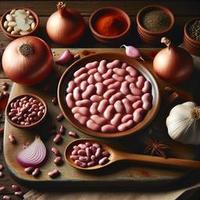
1 serving (185 grams) contains 364 calories, 15.6 grams of protein, 12.9 grams of fat, and 47.9 grams of carbohydrates.

Log this food in SnapCalorie

Nutrition Information
Calories |
364.4 | ||
|---|---|---|---|
% Daily Value* |
|||
| Total Fat | 12.9 g | 16% | |
| Saturated Fat | 1.9 g | 9% | |
| Polyunsaturated Fat | 5.2 g | ||
| Cholesterol | 0 mg | 0% | |
| Sodium | 403.3 mg | 17% | |
| Total Carbohydrates | 47.9 g | 17% | |
| Dietary Fiber | 9.1 g | 32% | |
| Sugars | 0.6 g | ||
| protein | 15.6 g | 31% | |
| Vitamin D | 0 mcg | 0% | |
| Calcium | 90.7 mg | 6% | |
| Iron | 4.0 mg | 22% | |
| Potassium | 873.2 mg | 18% | |
* Percent Daily Values are based on a 2,000 calorie diet. Your daily values may be higher or lower depending on your calorie needs.
Food Attributes
Source of Calories
About Pink beans
Pink beans, also known as "Santa Maria pinquitos," are small, oval-shaped legumes commonly featured in Latin American and Caribbean cuisines. With a mild yet slightly nutty flavor, they serve as a versatile base for dishes like chili, stews, and traditional refried beans. Originating from the Americas, pink beans are packed with nutrients, including protein, dietary fiber, and essential minerals such as iron, potassium, and magnesium, making them an excellent plant-based protein source. Their high fiber content supports digestion and helps maintain heart health by reducing cholesterol levels. They’re naturally low in fat and free from cholesterol, aligning well with balanced diets. However, preparation methods like frying or adding heavy amounts of salt can reduce their nutritional benefits. For vegetarian or vegan meals, pink beans pair well with grains and vegetables to create a satisfying, nutrient-rich dish.



